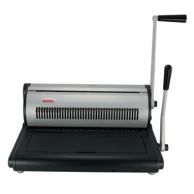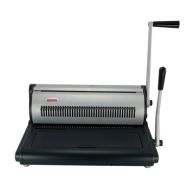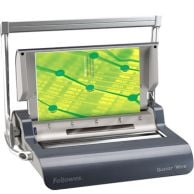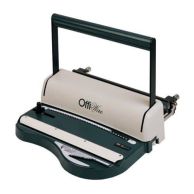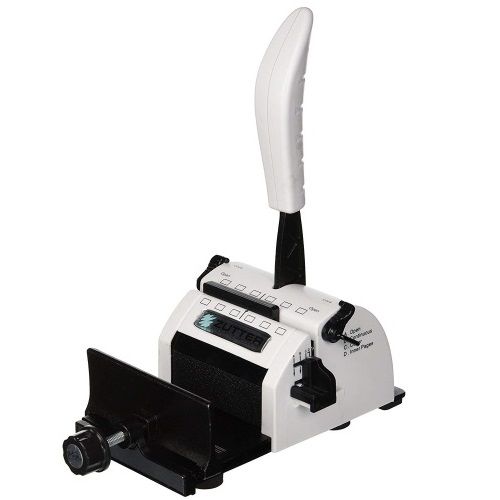We're sorry, but we no longer offer this item.
Call us at 1-800-944-4573 for personalized recommendations
or check out these similar items that may be a good fit:
Zutter Bind-it-All V2.0 Punch and Bind Machine
- 0
- 1
- 2
Product Description
Product Details
- Product Type: Punch and Bind Machine
- Color: White
- Quantity: 1
- Warranty: 1-Year Limited Warranty
- Product Number:ZUT2811
Demonstration Video
Zutter Bind-it-All - Chapter 3 Let's Punch Video
First, there’s setting A or Open. This provides an open punching channel that allows the material to move freely in either dire ... Read More
Now that you know a little bit about the machine, let’s get started with punching. By far, this is the most stressful operation users face. How many holes do I punch? How do I make the holes not go off the edge? And how do I keep them even? All that will be answered right now. In order to punch like a pro, you need to understand the settings of the paper stop guide. Knowing how and when to use the settings can help you punch both small and large projects with ease.
First, there’s setting A or Open. This provides an open punching channel that allows the material to move freely in either direction. This is used for long project punches and for when you want to punch beginning in the center of the project. Setting B is for continuous punching. When you’re punching project longer than 4 inches, engage the stop guide tab into a punched hole. This perfectly aligns the punchers no matter the length of the project. Setting C is for punching covers, and setting D is for punching inner pages. Why have two different settings for covers and pages? Zutter makes pre-cut covers and inner pages, and for professional quality binding, the inner pages are slightly smaller than the covers; smaller by about 3/16 of an inch. See how they provide an inner border around the pages? In order to have the punch holes align with these two different sizes, they need to be punched on these different settings, thus, C and D. However, if you’re using covers and inner pages that are exactly the same size, don’t use the D setting. Just punch everything on C for covers. Let’s start by punching a 4-inch mini-book cover and pages. For this sized book, the widths are the same as the Bind-it-All. You can set your paper stop guide on C for cover setting and place the chipboard in the punching channel, making sure the bottom is sitting flat and flush toward the stop guide. Hold it firmly and bring the handle down to punch. For the inner pages, repeat the same steps. However, change the stop guide to D for inner pages. Set them in the punching channel, make sure they’re flat and flush against the stop guide, bring down the handle and punch. Remember, this Bind-it-All version 2.0 has a greater capacity for material thickness, an additional 35% over the original model, giving you more flexibility. Try lining your covers with a variety of paper thicknesses or even fabric. You can stretch your creativity by punching covers from acrylic, thin wood, thin tin and plastic. Now, if you want to punch a longer album, in this case 8 inches, you will follow the same basic steps as before. However, because the Bind-it-All punches six holes at a time, depending on the width of the project, you will punch each cover multiple times.
Refer to your owner’s manual for detailed punching guide to tell you the number of holes needed for various widths. In this example, we are punching an 8-inch album and we’ll need 14 holes for the full length. Set the stop guide on C for cover setting, place the chipboard in the punching channel, make sure the bottom is sitting flat and flush toward the stop guide, hold it firmly and bring the handle down to punch. Move the stop guide to A, open setting, and slide the cover to the right, counting over to the fifth hole that you’ve punched. Engage the stop guide tab into the fifth hole. Bring the handle down to punch. Repeat the step again, this time engaging the seventh punched hole. Bring the handle down again, and you have perfect aligned even holes. For the inner pages, repeat these same steps. However, change the stop guide to D for inner pages for your first set of punches. Set them in the punching channel, make sure they’re flat and flush against the stop guide, bring down the handle and punch. All right, and then you have perfectly lined holes in your inner pages that correspond to your punched cover. Look at that, perfectly lined up. Here’s a tip. Make sure you punch the holes before you add any heavy or thick embellishment, especially if they’re near the spine of the edge of your project. Otherwise, it’s going to interfere with the punching action. Now that we have our two projects punched, let’s get ready to bind them.


